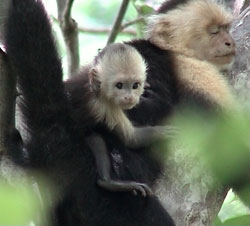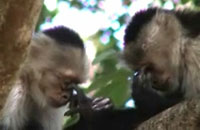|
|
|

|
|

|
|
|
Current Projects
Developmental study:
Since 2001, we have been conducting a longitudinal study of infant development
on 50 subjects residing in 5 social groups of wild white-faced capuchins
at Lomas Barbudal. These animals have been the subject of intensive focal
sampling (over 7,000 hours of focal data as of 2006). We are interested
in the effects of demographic factors, social learning opportunities,
personality, and experience on the development of these animals’
foraging skills and social strategies.
|
|
|
|
|
|
|
|
 Specific
goals: Specific
goals:
The primary goal of this study has been to document the precise nature
of the role of social influence on the acquisition of various traits,
such as relationship negotiation skills, food processing techniques, and
classification of animal species as dangerous, edible, or neutral. We
also hope to be able to document how various personality traits influence
the ability to learn, either asocially or socially.
There are many other questions that we would also like to
address with this data set, in addition to the questions pertinent to
social learning. For example, how do sex differences in behavior emerge
developmentally? What can developmental studies tell us about the
emergence of a female-bonded society in capuchins (note that female
philopatry is anomalous among platyrrhine primates) and the manner in
which females attain their dominance ranks? What factors affect the
timing of juvenile males’ migration decisions, their choice of
destination, and their selection of co-migration partners? Are young capuchins
capable of detecting who are their kin through the paternal line? What
factors contribute to adolescent females’ mothering styles?
|
|
|
|
|
|
|

|

|

|
|
|
|
|
|
|
The database:
Our focal individuals are members of 5 social groups which vary according
to size, stability of male membership, and degree of relatedness among
individuals. (Click
here for more information on the study groups.)
All social groups are completely habituated and most have been the
subjects of long-term observation (ranging from 1-15 years of observation
preceding the onset of this phase of study). Geneologies, constructed on
the basis of behavioral and genetic information, are complete or
virtually complete for these groups.
The core database for the longitudinal study consists of
10-minute focal follows of each infant, in which we record all
occurrences of social interactions (including gestural, olfactory and
vocal communication), manipulations of plants and insects, food
processing and ingestion, and interactions with members of other species.
Continuous observations are supplemented by instantaneous scans recording
the proximities of other group members. During focal follows, we also
record the activities of all group members within 5 body lengths of the
focal, and note whether the focal is visually attending to these
behaviors, so that we have a record of learning opportunities for each
animal as it develops. As of June 2006, we have well over 6,500 hours of
focal follows. The entire data set since the inception of the monkey
project in 1990 includes over 35,000 hours of contact time with the study
groups.
|
|
|
|
|
|
|

|

|

|
|
|
|
|
|
|
This core database is supplemented by various other types of data
collection:
|
|
|
|
|
|
|
|
(a)We collect group scans every 30 minutes in which we
note the spatial structure of the group and the activities of each group
member. These data help us document social networks for those animals
that are not included among our focal subjects. Ad libitum sampling is
used to note important events that help us monitor changes in social
dynamics among the adults: e.g. dominance interactions, coalitions, sex,
grooming, and bonding rituals of various kinds.
|
|
|
|
|
|
|

|

|

|
|
|
Top
|
|
|
|
|
|
|
|
(b)When the animals are foraging on foods that require
particularly complex forms of processing, we have a special protocol for
capturing the precise motor details of the techniques used for all group
members and the extent to which group members monitor one another during
these activities.
|
|
|
|
|
|
|

|

|

|
|
|
|
|
|
|
(c) We have made approximately 190 hours of audio recordings,
documenting vocal development in our focal subjects and also the adults.
This can help us document the extent to which there is variability in
acoustic structure across study groups, and also determine the degree to
which call structure is developmentally flexible.
|
|
|
|
|
|
|

|

|

|
|
|
|
|
|
|
 (d) We make
video recordings, focusing primarily on the details of culturally
variable “bonding rituals” such as handsniffing and
eyeball-poking that occur in some of our study groups. (d) We make
video recordings, focusing primarily on the details of culturally
variable “bonding rituals” such as handsniffing and
eyeball-poking that occur in some of our study groups.
|
|
|
|
|
|
|

|

|

|
|
|
Top
|
|
|
|
|
|
|
|
(e) We have collected fecal or tissue samples from all
members of our study groups, with the exception of a few early
infanticide victims in which the bodies could not be recovered, in order
to obtain DNA for paternity assignment.
|
|
|
|
|
|
|

|

|

|
|
|
|
|
|
|
(f)Experienced field assistants (i.e. those who have been
with the project for a year or more) complete questionnaires on the
monkeys’ personality traits.
|
|
|
|
|
|
|

|

|

|
|
|
|
|
|
|
(g) We collect fecal samples in order to measure corticosteroids and
testosterone levels.
|
|
|
|
|
|
|

|

|

|
|
|
|
|
|
|
(h) We conduct longer focal samples (up to 12 hours in
length) on those monkeys who exhibit interesting bonding rituals, to
study the effects of these communicative behaviors on relationship
quality.
|
|
|
|
|
|
|
|
|
|
|
|
|
|
|
|
|
|
|
|
|
|
|
|